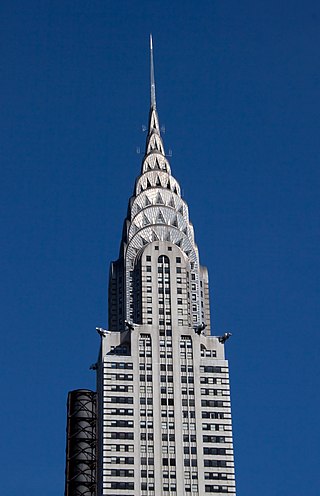
Art Deco, short for the French Arts décoratifs, and sometimes referred to simply as Deco, is a style of visual arts, architecture, and product design, that first appeared in Paris in the 1910s, and flourished in the United States and Europe during the 1920s to early 1930s. Through styling and design of the exterior and interior of anything from large structures to small objects, including how people look, Art Deco has influenced bridges, buildings, ships, ocean liners, trains, cars, trucks, buses, furniture, and everyday objects like radios and vacuum cleaners.

Newcastle upon Tyne, or simply Newcastle, is a city and metropolitan borough in Tyne and Wear, England. It is located on the River Tyne's northern bank, opposite Gateshead to the south. It is the most populous settlement in the Tyneside conurbation and North East England.

Tyne and Wear is a ceremonial county in North East England. It borders Northumberland to the north and County Durham to the south, and the largest settlement is the city of Newcastle-upon-Tyne.

Newcastle University is a public research university based in Newcastle upon Tyne, North East England. It has overseas campuses in Singapore and Malaysia. The university is a red brick university and a member of the Russell Group, an association of research-intensive UK universities.
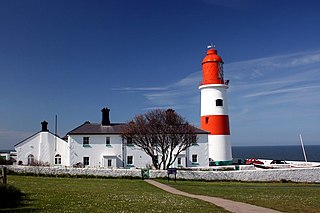
South Tyneside is a metropolitan borough in the metropolitan county of Tyne and Wear, North East England.
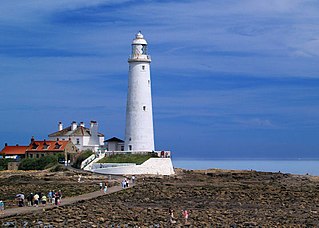
North Tyneside is a metropolitan borough in the metropolitan county of Tyne and Wear, England. It forms part of the greater Tyneside conurbation. North Tyneside Council is headquartered at Cobalt Park, Wallsend.

South Shields is a coastal town in South Tyneside, Tyne and Wear, England; it is on the south bank of the mouth of the River Tyne. The town was once known in Roman times as Arbeia and as Caer Urfa by the Early Middle Ages. It is the fourth largest settlement in Tyne and Wear, after Newcastle upon Tyne, Sunderland and Gateshead.

North Shields is a town in the Borough of North Tyneside in Tyne and Wear, England. It is 8 miles (13 km) north-east of Newcastle upon Tyne and borders nearby Wallsend and Tynemouth.
Monkseaton is an area of Whitley Bay, North Tyneside, in the North East of England. Historically in Northumberland, it is in the north-east of the borough, 3⁄4 mile from the North Sea coast and 1+1⁄2 mi (2.5 km) north of the River Tyne at North Shields. One mile to the north of Monkseaton, the extensive built-up areas of North Tyneside change abruptly into green belt stretching north into south-east Northumberland. It is at an elevation of 130 feet (40 m) above sea-level.

The North Tyneside Steam Railway and Stephenson Steam Railway are visitor attractions in North Shields, North East England. The museum and railway workshops share a building on Middle Engine Lane adjacent to the Silverlink Retail Park. The railway is a standard gauge line, running south for 2 miles (3.2 km) from the museum to Percy Main. The railway is operated by the North Tyneside Steam Railway Association (NTSRA). The museum is managed by Tyne and Wear Archives and Museums on behalf of North Tyneside Council.

Wylam is a village and civil parish in the county of Northumberland. It is located about 10 miles (16 km) west of Newcastle upon Tyne.

Newburn is a semi rural parish, former electoral ward and former urban district in western Newcastle upon Tyne, North East England. Situated on the North bank of the River Tyne, it is built rising up the valley from the river. It is situated approximately 5 miles (8 km) from the city centre, 14 miles (23 km) east of Hexham and 13 miles (21 km) south south west of Morpeth. In the 2001 census, the population was given as 9,301, increasing to 9,536 at the 2011 Census. Newburn is in the Newcastle upon Tyne district of Tyne and Wear and is part of the parliamentary constituency of Newcastle upon Tyne North.

The Empire Exhibition was an international exhibition held at Bellahouston Park in Glasgow, Scotland, from May to December 1938.

The Discovery Museum is a science museum and local history museum situated in Blandford Square in Newcastle upon Tyne, England. It displays many exhibits of local history, including the ship, Turbinia. It is managed by Tyne & Wear Archives & Museums.

Wylam Railway Bridge is a footbridge and former railway bridge crossing the River Tyne at Hagg Bank, approximately 1⁄2 mile (0.8 km) west of Wylam in Northumberland, England.

Plaza San Martín is a park located in the Retiro neighbourhood of Buenos Aires, Argentina. Situated at the northern end of pedestrianized Florida Street, the park is bounded by Libertador Ave. (N), Maipú St. (W), Santa Fe Avenue (S), and Leandro Alem Av. (E). Its coordinates are 34°35′42″S58°22′32″W.
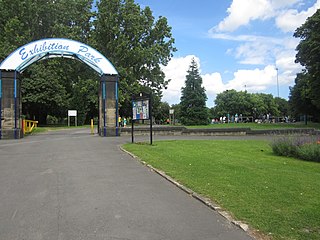
Exhibition Park is a public park connected to the south-eastern corner of the Town Moor, Newcastle upon Tyne, England. The park is home to numerous facilities including sports areas, a boating lake, playgrounds and a skatepark.
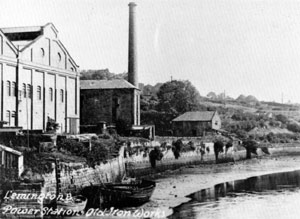
Lemington Power Station was a small, now demolished coal-fired power station, located in North East England. It was situated on the Lemington Gut, a backwater of the River Tyne, at Lemington, 3.5 mi (5.6 km) west of Newcastle upon Tyne. The station's main building stood until 2017 as a rare example of an early power station, dating from before the nationalisation of the United Kingdom's electrical supply industry.
Statue of Industry was a 1929 sculpture by the English artist Herbert Maryon. The 23-foot (7-metre) tall work depicted a woman with a model of Tyne-built RMS Mauretania in one hand, a model of a turbo alternator in the other, and three children at her feet. It was a prominent attraction at the North East Coast Exhibition, a world's fair–type event in Newcastle intended to showcase the manufacturing-centric capabilities of a region which was in the midst of a post-war recession. It remained at the Exhibition from May 1929 opening to October 1929 closing. Afterwards, the plaster-on-steel statue was copper-metalized to better withstand the elements, and sold to the engineering firm A. Reyrolle & Company in Hebburn; it remained there until at least 1931.


















